Educational
Resource Spotlight: Healthy Eyes Toolkit
Promote eye exams in your community. Use the Healthy Eyes Toolkit.
Healthy Vision Community Programs Database

This easy-to-search resource can help you learn about new ways to address eye health issues and replicate eye health-related projects in your community. Visit the Healthy Vision Community Programs Database at /nehep//.
The National Eye Health Education Program is coordinated by the National Eye Institute, National Institutes of Health, U.S. Department of Health and Human Services. This administrative document may be reprinted without permission.
In This Issue:
-
CDC Offers Free, Web-Based Health Literacy Training for Public Health Professionals
-
American Optometric Association CD Details Impact of Diabetes on Eyes
-
Brave Kids Helps Children with Chronic, Life-Threatening Illnesses and Disabilities
-
Lighthouse International Acquires National Association for Visually Handicapped
-
National Council on Aging Addresses Older Adult Falls Through New Falls FreeT Initiative
-
Prevent Blindness America Offers Workplace Programs to Protect Vision
-
Miami Lighthouse Heiken Children's Vision Program Helps Thousands
-
Healthy Vision Community Award Spotlight: Emmanuel Baptist Church

Letter From the Chair of the NEHEP Planning Committee
Most Americans are not aware that there are blinding eye diseases that have no early warning signs. As revealed by the Survey of Public Knowledge, Attitudes, and Practices Related to Eye Health and Disease, many people are unaware of the importance of comprehensive dilated eye exams in detecting early-stage eye disease and in attaining the best possible visual acuity. More than 11 million Americans have uncorrected refractive error, with nearsightedness, farsightedness, astigmatism, and presbyopia being the most common causes of visual impairment in the United States.1 In fact, a recent National Eye Institute (NEI) study also found that the prevalence of nearsightedness has increased 66 percent over the last 30 years.2 Fortunately, refractive errors are usually correctable with the appropriate prescriptive eyewear such as eyeglasses or contact lenses. To the extent that the public is unaware of the importance of comprehensive dilated eye exams, eye health professionals have an opportunity through our educational activities to explain the health benefits and quality-of-life impact of comprehensive dilated eye exams.
This May, I invite you to join NEI in celebrating Healthy Vision Month (HVM). Held each year since 2003, HVM was established to elevate vision as a health priority for the Nation. In the past, HVM has focused on topics such as eye safety and injury prevention, glaucoma, and children’s eye health. In 2009, the focus was on increasing awareness about uncorrected refractive error and the importance of eye exams, particularly among women. NEI is seeking to reinforce these messages in HVM 2010 by producing educational materials and resources, working with media such as major magazines, expanding partnerships with health and wellness organizations, and conducting a national radio media tour—all in an effort to communicate the public health impact of regular eye exams.
Promoting eye health at the community level is also a key component of the broader effort to achieve healthy vision for everyone. I encourage you to participate in HVM 2010 by reaching out in your local community, sharing information about the role of eye exams in detecting eye diseases, and in identifying and correcting refractive errors. The Healthy Eyes Toolkit offers a variety of resources that can be integrated into educational outreach efforts.
Please contact us at the National Eye Health Educational Program (NEHEP) to let us know about your efforts to promote eye health during HVM and beyond. We would especially appreciate any feedback on how you have used NEHEP materials and how those materials could be enhanced. We all have an important role to play in making vision a health priority, and every effort makes a difference. We look forward to hearing from you.
Anne Louise Coleman, M.D., Ph.D.
Chair, National Eye Health Education Program Planning Committee
Frances and Ray Stark Professor of Ophthalmology
Jules Stein Eye Institute
David Geffen School of Medicine at UCLA
and
Professor of Epidemiology
UCLA School of Public Health
References:
1 Vitale, S., Cotch, M. F., & Sperduto, R. D. (2006). Prevalence of visual impairment in the United States. The Journal of the American Medical Association, 295(18), 2158–2163.
2 Vitale, S., Sperduto, R.D., Ferris III, F.L. (2009). Increased Prevalence of Myopia in the United States Between 1971–1972 and 1999–2004. Archives of Ophthalmology, 127(12): 1632–1639.
New NEHEP Report on Primary Care Physicians and Eye Health
Primary care physicians can influence patient behavior and play a critical role in maintaining and improving the eye health of their patients.1,2 To assist in the management of eye health and diseases, primary care physicians should understand the natural history of eye diseases, know how to recognize those at higher risk of developing severe vision loss, and be able to interpret the earliest symptoms of the disease.3 Because they see their patients on a regular basis, primary care physicians are in a unique position to prevent vision loss and blindness. They can manage systemic diseases that impact eye health and encourage patients to undergo periodic evaluation by eye care professionals and receive needed eye care.4 In fact, recent research from the National Eye Institute (NEI) found that almost all adults (96%) say they would be somewhat or very likely to have their eyes examined if their primary care physician suggested they do so.
In order to determine primary care physicians’ knowledge, attitudes, and practices regarding eye health and disease, NEI conducted a survey to  examine what primary care physicians report knowing, believing, and practicing about vision and eye health with their patients. The data were collected using a web-based survey of a random sample of 1,500 primary care physicians practicing in the United States.
examine what primary care physicians report knowing, believing, and practicing about vision and eye health with their patients. The data were collected using a web-based survey of a random sample of 1,500 primary care physicians practicing in the United States.
Of those surveyed, only 51 percent of physicians believe they have adequate knowledge to advise their patients on vision health. Further, only 58 percent believe they can identify patients at higher risk for eye disease. Physicians who treat patients with diabetes, however, reported that they discuss eye health and disease more frequently with their patients, counsel patients about the eye health complications of diabetes, and encourage patients to seek regular eye examinations.
Findings from this research reveal a need and an opportunity to better educate primary care physicians with regard to eye health and disease including how to recognize patients at higher risk of blindness and how to best counsel and refer their patients to seek vision care.
The full report can be accessed at http://www.nei.nih.gov/nehep/research/Manuscript.pdf.
References:
1 Varma, R., Ying-Lai, M., Klein, R., and Azen, S. (2004). Prevalence and Risk Indicators of Visual Impairment and Blindness in Latinos. The Los Angeles Latino Eye Study. Ophthalmology, 111: 1132–1140.
2 Higginbotham, E., and Rust, G. (2008). Ophthalmology and Primary Care: Partners in Peril? Archives of Ophthalmology, 126: 727–728.
3 Bressler, N.M., (2002). Early Detection and Treatment of Neovascular Age-Related Macular Degeneration. Journal of the American Board of Family Medicine, 15(2): 142–152.
4 Rowe, S., MacLean, C.H., and Shekelle, P.G. (2004). Preventing visual loss from chronic eye disease in primary care. Journal of the American Medical Association, 291(12): 1487–1496.
Join Us in May for Healthy Vision Month
Comprehensive dilated eye exams are crucial to preserving sight and maintaining healthy eyes. Because of this, the National Eye Institute (NEI) will continue its 2009 efforts to promote the importance of eye exams during Healthy Vision Month (HVM) in May, especially among women. Outreach strategies will include expanding the Healthy Eyes Toolkit, working with media such as major magazines, building partnerships with health and wellness organizations, and conducting a national radio media tour.
Promoting eye health at the community level is a key component of the broader effort to achieve healthy vision for everyone. Please join NEI in continuing to raise awareness about the importance of eye exams. You can do this by planning and participating in activities that educate your community about the importance of dilated eye exams in detecting eye diseases and conditions, and identifying refractive errors.
The Healthy Eyes Toolkit offers a variety of resources that can help you educate others about the role of regular eye exams in maintaining good 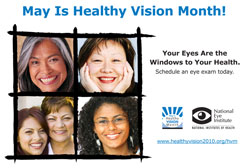 eye health. You’ll find a variety of educational tools such as e-cards, print and radio public service announcements, sample text messages, drop-in articles, fact sheets, downloadable posters, bookmarks, and stickers that can be used to spread the word about eye health. Here are just a few resources you’ll find in the Toolkit and ideas for using them:
eye health. You’ll find a variety of educational tools such as e-cards, print and radio public service announcements, sample text messages, drop-in articles, fact sheets, downloadable posters, bookmarks, and stickers that can be used to spread the word about eye health. Here are just a few resources you’ll find in the Toolkit and ideas for using them:
Drop-In Articles: Get the word out! See What You’ve Been Missing is a general article that you can send to local newspapers or use in newsletters, publications, or on websites. Your Eyes Your Health is an article targeted to women about how important it is for them to take care of their vision. Place it in newsletters, local magazines, or on websites that are popular with women. You can also print out hard copies and ask local beauty salons and day spas if you can leave some for their patrons in a reading rack or on a counter. Both articles are available in English and Spanish.
Electronic Messages: Start a chain reaction! Send an e-card or use one of the text messages to remind friends, family, and colleagues about the importance of having an eye exam. Encourage each contact to send the message to their family and friends—they should encourage others to do the same. You get the idea!
Downloadable Bookmarks and Stickers: Give it away! Make presentations at health fairs and other community events. Bring a supply of bookmarks to give out to participants to remind them to schedule an eye exam or drop some off at your local library or bookstore. Try organizing an eye health event or screenings in your community and give a sticker to each person who has his or her eyes examined.
NEI Healthy Eyes Webpage: Put a link to www.nei.nih.gov/healthyeyes on your website and encourage others to visit the site for eye health information.
For these and other resources, visit the Healthy Vision Month Website at http://www.nei.nih.gov/hvm/.
NEHEP Launches New Diabetic Eye Disease PSA Campaign
The National Eye Health Education Program (NEHEP) has recently developed a series of print public service announcements (PSAs) in English and Spanish to help increase awareness of diabetic eye disease and the importance of dilated eye exams among three priority audiences:
- African Americans
- Hispanics/Latinos
- Older adults
All of the PSA messages and photos were pretested with  the target audiences who either have diabetes themselves or are loved ones of people with diabetes. Each PSA emphasizes that diabetic eye disease has no early warning signs and encourages people with diabetes to get a dilated eye exam at least once a year. In addition, the PSAs direct people to the National Eye Institute’s diabetic eye disease webpage and provide a toll-free number for people to get more information.
the target audiences who either have diabetes themselves or are loved ones of people with diabetes. Each PSA emphasizes that diabetic eye disease has no early warning signs and encourages people with diabetes to get a dilated eye exam at least once a year. In addition, the PSAs direct people to the National Eye Institute’s diabetic eye disease webpage and provide a toll-free number for people to get more information.
As part of American Diabetes Month in November 2009, the PSAs were distributed to 1,500 publications that reach the campaign’s target audiences. To increase reach, the ads were also placed on interior bus cards in five markets: New York, Philadelphia, Chicago, Dallas, and Los Angeles through the early part of 2010. These cities were chosen because they are top media markets for African Americans and Hispanics/Latinos, have high incidence rates of diabetes, and have high ridership on transit systems.
As with all NEHEP resources and materials, these diabetic eye disease PSAs are available for you to use in your own publications and outreach efforts. They are all available for download at http://www.nei.nih.gov/photo/keyword.asp?conditions=Diabetic.
CDC Offers Free, Web-Based Health Literacy Training for Public Health Professionals

Health literacy is the degree to which an individual can understand health information needed to make appropriate health decisions. It is more than just reading. It’s also math, being able to understand insurance forms, ask questions, and so much more. Health literacy encompasses all the skills people need to make important decisions affecting their health. In order to help others understand vital health information, health professionals must be able to provide information in a manner that is easy to understand and culturally appropriate.
Nearly 9 out of 10 adults in the United States may lack the skills needed to manage their health. Limited health literacy often leads to higher costs and poorer health outcomes.
The Centers for Disease Control and Prevention is pleased to make available a new, free web-based training, Health Literacy for Public Health Professionals. The training offers essential information about health literacy and provides practical strategies and tools to help public health professionals improve their effectiveness in educating and providing others with useful resources that will meet their needs. Those who may benefit from the training include:
|
|
Continuing education credits are available in some disciplines. To access the training go to www.cdc.gov/healthmarketing/healthliteracy/training.
American Optometric Association CD Details Impact of Diabetes on Eyes
A new, updated edition of the American Optometric Association’s (AOA) highly popular Healthy Eyes Healthy People® Diabetes CD allows 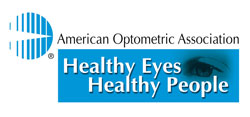 public health officials, healthcare professionals, and diabetes educators to easily access a range of helpful, evidence-based public education materials on the ocular manifestations of diabetes.
public health officials, healthcare professionals, and diabetes educators to easily access a range of helpful, evidence-based public education materials on the ocular manifestations of diabetes.
Introduced several years ago to provide a compendium of the most widely used AOA information on diabetes-related eye problems in a convenient digital form, the Healthy Eyes Healthy People® Diabetes CD proved an immediate hit with diabetes care professionals across the Nation. The new revised version of the Healthy Eyes Healthy People® Diabetes CD includes additional materials from the National Diabetes Education Program (NDEP) and National Eye Health Education Program (NEHEP).
Copies of the Healthy Eyes Healthy People® Diabetes CD can be purchased for a nominal fee by contacting the AOA Order Department at 1–800–262–2210. For more information, contact Uzma Zumbrink, AOA Associate Director of Public Health, Clinical and Practice Advancement Group at 314–983–4146 or at uazumbrink@aoa.org.
Brave Kids Helps Children with Chronic, Life-Threatening Illnesses and Disabilities
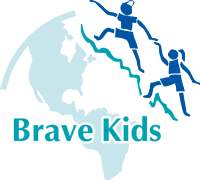
Brave Kids is a nonprofit organization that helps children with chronic, life-threatening illnesses and disabilities. Kristen Fitzgerald founded Brave Kids in June 1999, after losing her own two children to catastrophic illnesses. The organization helps seriously ill children and their families find resources and emotional support. Among other services, Brave Kids (http://www.bravekids.org) created a user-friendly online community that offers:
- A directory of healthcare resources based on zip codes for children with special needs. This enables caretakers to easily locate healthcare resources and support for children in their community who are ill or disabled.
- The most recent and accurate medical information for family members.
- Message boards that give emotional support to children with special needs and their parents by connecting them to others in similar situations around the world.
Blind/vision impaired is one of more than 60 conditions that can be researched on the Brave Kids Website to locate a wide array of specific local and national resources in areas such as assistive technology, camps, medical assistance, sports, and support groups to name a few.
In addition to the online community, Brave Kids also offers:
- Brave Kids Resource Centers, located in pediatric wards of some hospitals, which enables parents to locate medical information and local resources while they are in the hospital with their child.
- Community outreach that provides education and training on locating community resources for children with special needs.
For more information about Brave Kids, contact them at 904–280–1895, 1–800–568–1008, or info@bravekids.org.
Lighthouse International Acquires National Association for Visually Handicapped

The Board of Directors of Lighthouse International and the Board of Directors of the National Association for Visually Handicapped (NAVH) recently announced that Lighthouse International has acquired NAVH.
Both organizations have a shared mission and a long history of helping people who are visually impaired through a wide range of programs from low vision services to assistive devices to support groups. Lighthouse International will continue this tradition of service and create a new program named in honor of NAVH founder and CEO Emeritus Lorraine Marchi, L.H.D.
“By combining forces, we will be better able to serve the needs of the growing number of people who are visually impaired. We are also pleased to continue the fine legacy of Dr. Lorraine Marchi by creating a new, expanded social services program in her honor,” states Roger O. Goldman, Chairman of the Board of Directors of Lighthouse International.
The new program will help clients overcome the challenges of vision loss through counseling, support groups, educational materials, and referrals to other services available at Lighthouse International or state or other agencies. The program is expected to begin in the spring.
According to Marvin Sandler, President, NAVH Board of Directors, “Because of its excellent reputation for services in the community, we determined that joining with Lighthouse International would be in the best interests of our organization and the people we have served for 55 years.” NAVH clients or referring physicians can contact Miriam Rosen, Executive Director of NAVH, at 212–821–9458, or at mrosen@lighthouse.org for further information.
Founded in 1905, Lighthouse International is a leading nonprofit organization dedicated to fighting vision loss through prevention, treatment, and empowerment. It achieves this through clinical and rehabilitation services, education, research, and advocacy. For more information about vision loss and its causes, contact Lighthouse International at 1–800–829–0500 or visit www.lighthouse.org.
National Council on Aging Addresses Older Adult Falls Through New Falls Free™ Initiative
There is a growing epidemic of falls and fall-related injuries among older adults, which are the leading causes of serious injury and death among people aged 65 and older. Given the aging of the population, greater attention to falls is needed to meet the growing demands. Fortunately, falls are largely preventable. Risk factors, such as impaired vision, can be reduced through intervention.
adults, which are the leading causes of serious injury and death among people aged 65 and older. Given the aging of the population, greater attention to falls is needed to meet the growing demands. Fortunately, falls are largely preventable. Risk factors, such as impaired vision, can be reduced through intervention.
In 2007, there were nearly 1.9 million older adult fall injuries treated in emergency rooms. Of these, over 433,000 patients were admitted to hospitals. Although not requiring long stays, fall-related injuries had a higher average cost ($10,800) relative to older adults admitted from the emergency department for other reasons ($9,900). In the same year, nearly 17,000 older adults died as a result of a fall event.1
Many older adults who fall, even those who are not injured, develop a fear of falling, which causes them to limit their activities. This leads to reduced mobility and physical fitness, which increases an older adult’s actual risk of falling.2 Due to the rapidly aging general population, this issue will need action at the national, state, and local level to address this serious and growing problem.
Since 2004, the National Council on Aging’s (NCOA) Falls Free™ Initiative has been working to bring greater awareness to the issue by educating and training providers, and by advocating for a federal investment in community programs and services that reach older adults. Twenty-three states are now coalescing around the issue and have joined the active peer-learning network called the State Coalitions on Fall Prevention Workgroup.
Research on how to lower the incidence of falls points strongly to reducing commonly recognized risk factors for falling. The more risk factors an individual may have, the greater the risk of falling. These risk factors include:
- Gait and balance difficulties, muscle weakness and general physical inactivity
- Medications—the medications themselves and their interactions
- Slip, trip, and stumble hazards found within the surrounding environment
- Vision changes, vision disorders, and low vision
With regard to vision, a two-part issue brief, Falls and Vision Loss, Part 1 and Falls and Vision Loss, Part 2, developed by the Fall Prevention Center of Excellence provides an overview of common age-related eye diseases and outlines strategies for improving the safety of an environment to accommodate changes associated with aging and vision loss.
The National Eye Health Education Program (NEHEP) has recently joined the Falls Free™ Initiative and will work with NCOA to promote the importance of eye health and early detection among older adults.
For more information about the Falls Free™ Initiative, contact Lynn Beattie at bonita.beattie@ncoa.org.
References:
1 Centers for Disease Control and Prevention, National Center for Injury Prevention and Control. Web-Based Injury Statistics Query and Reporting System (WISQARS) [online]. (2009). [cited 2010 Jan 20]. Available from URL: www.cdc.gov/injury/wisqars.
2 Vellas, B.J., Wayne, S.J., Romero, L.J., Baumgartner, R.N., Garry, P.J. (1997). Fear of Falling and Restriction of Mobility in Elderly Fallers. Age and Aging, 26, 189–93.
Prevent Blindness America Offers Workplace Programs to Protect Vision
Because prevention is one of the best ways to keep healthcare expenses down, Prevent Blindness America (PBA), the nation’s oldest volunteer eye health and safety organization, offers the Healthy Eyes Vision Wellness Program. The program is free to employers and educates corporations and their employees on the importance of vision health, including warning signs of potential eye disease and safety tips on how to avoid vision-threatening eye accidents.
The program also offers educational and promotional materials that help deliver critical vision wellness information in the workplace. The materials  were developed by leading eye care professionals including ophthalmologists, optometrists, and research professionals and were designed to encourage employees to make vision care a health priority and to help to avoid needless pain and suffering from preventable eye diseases.
were developed by leading eye care professionals including ophthalmologists, optometrists, and research professionals and were designed to encourage employees to make vision care a health priority and to help to avoid needless pain and suffering from preventable eye diseases.
“By providing companies with the tools they need to educate their employees on the importance of regular eye care and practicing eye safety today, we hope to significantly decrease the number of preventable blindness cases in the future,” said Hugh R. Parry, President and CEO of PBA.
By joining the PBA Healthy Eyes Vision Wellness Program, participants will receive:
- Vision Wellness in the Workplace Promotion Guide
- Prevent Blindness America’s Healthy Vision Observance Calendar
- Monthly e-mailed vision health and safety posters, fact sheets, and eye health and safety news updates
- The Common Eye Myths poster
- Adult Vision Risk Assessment for employees
- Sample Healthy Eyes Vision Wellness Guide
Employers may benefit from the Healthy Eyes Vision Wellness Program by the potential for increases in worker productivity, the reduction of vision-related disability claims and health benefit costs, and a reduction of absenteeism, sick leave, and premature retirement due to vision-related illness or work-related eye injuries.
PBA has been dedicated to protecting vision in the workplace since 1948 when the Wise Owl Eye Safety Recognition Program was developed. The program continues to this day and provides safety education materials to employers to help avoid eye accidents for workers as well as offers recognition to companies and individuals who have saved vision through dedication to proper eye protection in the workplace.
To find out how your company can sign up for the Healthy Eyes Vision Wellness Program, the Wise Owl Eye Safety Recognition Program, or to receive free information on eye safety in the workplace, please call PBA at 1–800–331–2020, or visit www.preventblindness.org.
Miami Lighthouse Heiken Children's Vision Program Helps Thousands
The Heiken Children's Vision Program at Miami Lighthouse provides free, comprehensive eye examinations and eyeglasses for low-income school children in the Miami-Dade County community who have no other resource for vision care. The program was established in 2007, when Miami Lighthouse took on oversight of the Dr. Bruce Heiken Memorial Fund, which was originally established by local optometrists with the goal of meeting the vision care needs of local school children.
It was a natural fit, given that Lighthouse and the Heiken Fund shared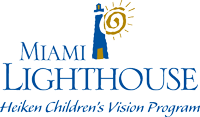 similar missions. With a national reputation and nearly 80 years of service in Miami-Dade County, along with its strong infrastructure and fiscal soundness as evidenced by a four-star (exceptional) rating by Charity Navigator, Lighthouse ensured that the original intent of the creators of the Heiken Fund would continue. In just two years, Miami Lighthouse has been able to expand the Heiken mission by providing 2,500 school children with comprehensive dilated eye exams in 2007 and increasing that number to nearly 5,000 in 2009.
similar missions. With a national reputation and nearly 80 years of service in Miami-Dade County, along with its strong infrastructure and fiscal soundness as evidenced by a four-star (exceptional) rating by Charity Navigator, Lighthouse ensured that the original intent of the creators of the Heiken Fund would continue. In just two years, Miami Lighthouse has been able to expand the Heiken mission by providing 2,500 school children with comprehensive dilated eye exams in 2007 and increasing that number to nearly 5,000 in 2009.
The Miami Lighthouse Heiken Children's Vision Program works by taking vision care to the children where they need to receive it—at school. Two fully equipped mobile units serve as optometrists’ offices on wheels and travel to schools throughout the Miami-Dade County area. A network of 70 optometrists led by Miami Lighthouse low vision consulting optometrist, Dr. Rosemary Gonzalez, provides free comprehensive dilated eye exams and eyeglasses to children who need them.
Miami Lighthouse welcomes the expanded effort that taking over the Heiken Fund has created. One of the greatest challenges the program faces is obtaining signed parental permission forms that allow a child who has failed an initial vision screening to have a comprehensive dilated eye exam. Ongoing education by Miami Lighthouse to parents and teachers about the importance of regular comprehensive eye exams has been the most successful solution to securing parental permission. In addition, Miami Lighthouse continues to work on building a larger network of community eye health professionals.
One of the most rewarding aspects of the Heiken Children’s Vision Program is the letters of thanks that Miami Lighthouse receives almost weekly, from parents and children whose lives have been touched by it. Children formerly frustrated in class are proud of their ability to achieve academic success and know that their lives and futures have been changed for the better.
For more information about the Heiken Children’s Vision Program, contact Ms. Virginia A. Jacko at 305–856–4176 or at vjacko@miamilighthouse.org.NDEP Introduces New Resource to Support Lifestyle Changes
When a person is diagnosed with diabetes, the decisions they make each day about nutrition, physical activity, medicines, and schedules can have a significant impact on their health and well being.
The National Diabetes Education Program (NDEP) recognizes that the day-to-day activities needed to manage diabetes can be challenging, especially for people who may also be dealing with vision problems, a complication associated with diabetes. That’s why NDEP developed a new online resource, the Support for Behavior Change Resource (SBCR). This resource provides easy access to existing tools, programs, and research articles that address the “how to” of lifestyle and behavior change. All materials have been reviewed by experts in psychosocial issues and behavior change.
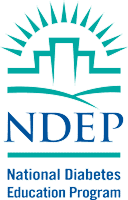 The Tools and Programs section of this online resource provides links to more than 100 tools and programs—including a few eye health tools such as the American Foundation for the Blind’s Guide to Caring for Yourself When You Have Vision Loss, which can assist healthcare professionals in working with people to make and sustain lifestyle changes. This section is geared toward consumers interested in adopting healthy behaviors. It can also be used by healthcare professionals and community groups interested in helping their patients and communities make and sustain healthy behaviors.
The Tools and Programs section of this online resource provides links to more than 100 tools and programs—including a few eye health tools such as the American Foundation for the Blind’s Guide to Caring for Yourself When You Have Vision Loss, which can assist healthcare professionals in working with people to make and sustain lifestyle changes. This section is geared toward consumers interested in adopting healthy behaviors. It can also be used by healthcare professionals and community groups interested in helping their patients and communities make and sustain healthy behaviors.
The Research Article section of the SBCR is aimed at healthcare professionals. It identifies 38 research articles that address psychosocial, lifestyle, and behavior change issues.
All materials included in the SBCR can be viewed by target area, such as physical activity, smoking cessation, weight management, healthy eating, and coping and emotions. Tools and programs can also be viewed by type of user, such as people with diabetes, people at risk, healthcare professionals, and children and teens. Research articles can be searched by behavioral strategies, including patient empowerment, motivational interviewing, and counseling.
For more information, visit www.YourDiabetesInfo.org/sbcr or contact Darise S. Deal at 202–842–3600, extension 229, or at ddeal@hagersharp.com.
Healthy Vision Community Award Spotlight: Emmanuel Baptist Church
The consequences of inadequate vision care or uncorrected vision impairment in children aged 17 and under include low academic performance, reading difficulty, slow learning, and adult illiteracy. The Bright Sight Vision Program was developed to assist with minimizing these effects.
There are two components of the program: 1) educating youth and parents or guardians about prevention of vision impairment and blindness as well as proper eye health and care, and 2) providing vision screenings. The target audience for the program is African American children from preschool age through 17 years old in Noxubee County, MS—an underserved, low-income area with limited education attainment.
Barriers to obtaining proper eye care in Noxubee County include lack of knowledge, lack of access, lack of transportation, and limited budgets. The Bright Sight Vision Program is designed to overcome several of these barriers. The education component provides factual information to dispel myths and increase knowledge related to eye health. There is no cost to participants who receive vision screenings and social workers are accessible to inform participants’ parents and guardians about local, state, and federal resources when follow up is needed due to a failed vision screening. By providing transportation to events where vision screenings are offered, the Bright Sight Vision Program addresses the issue of accessibility.
The Bright Sight Vision Program is implemented under the auspices of  Emmanuel Baptist Church (EBC). In 2009, EBC became the first faith-based organization to receive a Healthy Vision Community Award (HVCA) since the HVCA program began in 2003.
Emmanuel Baptist Church (EBC). In 2009, EBC became the first faith-based organization to receive a Healthy Vision Community Award (HVCA) since the HVCA program began in 2003.
EBC was established in 1993 and is currently one of the largest churches in Noxubee County. The program has been incorporated into several existing, multifaceted youth and family programs by making vision screenings available to children and by distributing eye health education materials to adults at established events. These include:
Fun Night. This event offers a carnival atmosphere with age-specific activities and prizes. Incorporating the Bright Sight Vision Program into Fun Night included developing activities and booths related to eye care tips, eye health strategies, and vision impairment prevention. Vision screening was provided for all children within the targeted age group.
Family Night. This EBC event occurs at the conclusion of Vacation Bible School. To support the Bright Sight Vision Program, a vision education session was incorporated into the agenda for the evening and vision screenings were offered. An educational DVD developed specifically for the target population was presented—it featured members of the Noxubee County community.
Dancing Rabbit Festival. The Dancing Rabbit Festival is an annual countywide event that consists of a day of entertainment, vendors, games, and recreation. EBC partnered with Macon Connections, an Internet cafe located in the heart of downtown Macon, MS, to host vision screenings during the festival.
These carnival-style events attract parents and children alike. Incentive prizes are used at each event since kids are more likely to encourage their parents to allow them to attend an event if there is a prize involved. During each event, parents were amazed that their child wanted to come and get a vision screening, which in turn encouraged the parents to take information about vision health. Following each event, EBC mailed letters to every parent to let them know whether their child passed or failed the vision screening. The biggest challenge EBC faced in carrying out the Bright Sight Vision Program was getting parents to follow up with an optometrist for those kids who failed the vision screening.
Over the course of the HVCA award period, EBC was able to screen 284 children, increasing the proportion of target audience members who received vision screening the previous year by 50 percent. The project also distributed literature on vision health to 252 adults. There are plans to continue the Bright Sight Vision Program beyond the HVCA award period through the use of in-kind contributions and partnerships with other civic groups.
For more information about the Bright Sight Vision Program, contact Marika Baliko at 662–726–4965 or marikabaliko@gmail.com.
On the Road With NEI
![]() NEI regularly exhibits at national meetings across the country. Exhibits provide an opportunity to share information and publications, promote NEI messages and resources, and strengthen links with partner organizations. Upcoming NEI exhibits are listed below. If you plan to attend this meeting, please stop by and say “hello”!
NEI regularly exhibits at national meetings across the country. Exhibits provide an opportunity to share information and publications, promote NEI messages and resources, and strengthen links with partner organizations. Upcoming NEI exhibits are listed below. If you plan to attend this meeting, please stop by and say “hello”!
National Council of La Raza
Annual Conference
Henry B. Gonzalez Convention Center
San Antonio, TX
July 10–13, 2010

